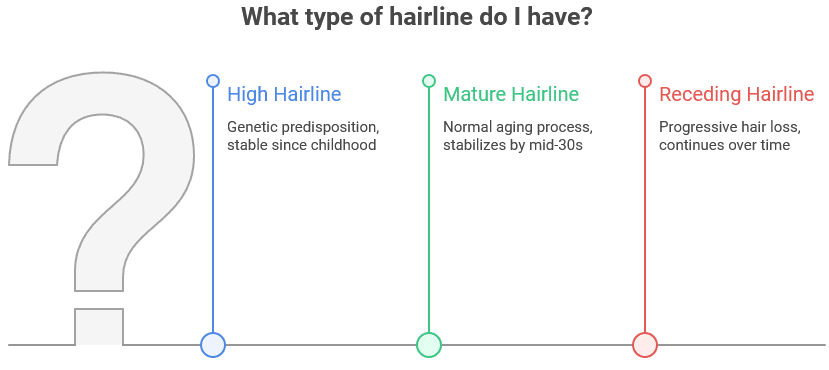Most tend to become self-conscious about their appearance as they age, especially when it comes to their hair shape. Now, noticing that your hairline is a bit higher than it used to be when you were young doesn’t mean your hairline is receding. After all, you may just have what is known as a mature hairline.
How can you tell if it’s a genetic trait, a regular part of aging, or a sign of male pattern baldness? We’ll go into all the important details and help you find out.
Did you know?
A higher hairline is often one of the first features that prompts concern about hair loss—especially in men. In fact, the 2025 ISHRS Practice Census found that 57.6% of patients underwent their first hair transplant surgery between the ages of 26 and 35, when many begin to notice a maturing or receding hairline. Understanding whether this shift is normal or an early sign of male pattern baldness is the key to choosing the right treatment path.
What Is a High Hairline?
Some people have a genetic predisposition for a prominent forehead, and their hairline starts further back than that of most people. They typically don’t exhibit any sign of hair loss and have the same characteristic shape since childhood.
On the other hand, some may start out with a lower forehead and notice a slight raising in the areas above the temples over the years, which is just the typical mature hairline. If it stabilizes by your early to mid-30s and there is no excessive thinning and continuous balding, it is no cause for concern.

High Hairline vs. Mature and Receding Hairlines
How do we distinguish between a genetically high forehead, a regular mature shape, and the initial stages of patterned hair loss? Here is a detailed comparison table to give you a good basic idea:
Feature | High Hairline | Mature Hairline | Receding Hairline |
Definition | Naturally high starting point of hair at the forehead | A slight, age-related shift of the juvenile hairline | Progressive hair loss that moves the hairline backward |
Cause | Genetic (often present from a young age) | Normal aging process, typically in men 20–30 years old | Often due to male pattern baldness or genetic factors |
Shape | Even, straight or U-shaped across the forehead | Slightly higher than juvenile, often forming a subtle “M” shape | Deep M-shaped recession at temples |
Stability Over Time | Generally remains unchanged | Stabilizes after initial movement | Often continues to recede over time without treatment |
Common Age Range | Present from childhood or adolescence | Develops in late teens to early 30s | It can begin as early as the late teens and continues with age |
Thinning Hair | Rare | Little to no | Common, especially at temples and the crown |
Treatment Needed | None | None | May require treatment if progression is unwanted |
Misconceptions | Sometimes mistaken for hair loss | Often mistaken for early balding | Clearly recognized as hair loss |
Non-Surgical Treatments for a High Hairline
There are several fairly effective treatment options for men and women who experience hair thinning and balding, but if you have a genetically high forehead or mature but healthy hair, these won’t do much.
- PRP Treatments: The doctors take a sample of your blood and spin it in a centrifuge to get a layer of platelet-rich plasma, which can be injected into the area to improve blood flow and strengthen the hair follicles.
- Medication: There are two proven hair loss drugs, Finasteride and Minoxidil, which help revitalise thin strands and improve overall density. They are only useful during the initial phases of balding.
- Steroid creams: This option is applied topically and is used primarily for female pattern hair loss in post-menopausal women
- Laser Therapy: A low-level laser is used to stimulate the roots to cause the weakened hairs to grow thicker and longer.
All these treatments have varied success rates, and the final result will depend on your particular situation, but there is also a more reliable and permanent solution.
Hairline Transplant to Lower a High Hairline
Receding hairlines in women and men alike can be treated with a 95–98% success rate using modern hair transplant procedures like Sapphire FUE and DHI.
These are minimally invasive, leaving almost imperceptible scars and offering natural-looking results within 12 months. They involve extracting grafts from the donor area at the back of the head and implanting them either directly or into pre-made incisions in the recipient area.
An alternative approach is forehead reduction surgery, where the surgeon cuts a strip of skin out of the forehead and sews everything back up to pull the hairline slightly closer and tighten the whole area. It leaves a small linear scar across the hairline, which some patients then choose to cover up with a subsequent hair transplant.
When to See a Specialist
If you’ve noticed a mature hairline appearance in the past few years and the bald spots above the temples have grown progressively, it is a clear sign of hair loss. Most doctors recommend waiting until your mid-thirties to determine the precise balding pattern and for the initial progression to slow down before getting a hair transplant in Istanbul.
In general, if you’ve tried natural remedies like rosemary and castor oil, as well as medications or other treatments we’ve mentioned, and are still losing hair, it’s time to schedule a consultation.
FAQs
What is considered a high hairline?
A common youthful hairline extends from just above the temples and across the forehead at more or less perpendicular angles, with either a slight upwards bow, a bell shape in women, or a crow’s peak extending downwards. When it is noticeably higher than the brow ridge or there is a subtle “M” shape, it is considered a high or mature hairline, respectively.
Are higher hairlines attractive?
It depends. People with a high forehead can be seen as more intelligent and, potentially, more attractive. In women, bell shaped hairlines are considered a unique and desirable trait, giving a more oval shape to the entire face, and are purely genetic.
How early can hairlines start receding?
It usually happens from the late 20s to mid-30s, although for some people it can start when they are only 18–20 years old.
Can I prevent my hairline from moving back?
Yes. Hair transplants can cause new hair growth and give you a more youthful hairline.

